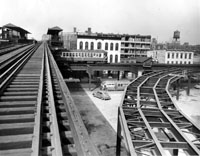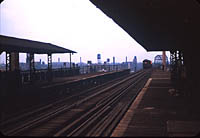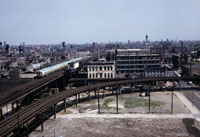
Lake Street Transfer station is seen looking east from the lower level Lake Street "L" platform. The upper platforms with the peaked-roof canopies are the Metrpolitan "L"'s platforms, who opened the original part of the station in 1895; the lower platforms were added in 1913 to create a transfer station. For a larger view, click here. (Photo from the Bruce G. Moffat Collection) |
Lake Street Transfer
(1700W/200N)
Lake Street and Paulina
Street, Near West Side
Service
Notes:

|
Logan Square
branch/Lake Street Line
|
Quick Facts:
|
Address:. |
1718-20? W. Lake Street (original Met station entrance on north side of Lake St.) |
|
1719 W. Lake Street (entrance on south side of Lake St.) |
Established: May 6, 1895
Original Line: Metropolitan West Side Elevated/Chicago
& Oak Park Elevated
Previous Names: Lake Street (Met "L" station pre-1913)
|
Skip-Stop Type:
|

|
Station
|
Rebuilt: 1913 (Added
C&OP platforms and free connection)
Status: Demolished
History:

A westbound C&OP train crosses under the Met Northwest branch. The entrance to the Met's Lake Street station is in the lower left; in 1913, platforms were added on the Lake Street "L" to the create Lake Street Transfer station. For a larger view, click here. (Photo from the Ed Frank Collection) |
What would eventually become a three-level transfer station at this location began as a simpler neighborhood station on the Metropolitan West Side Elevated's Northwest (Logan Square/Humboldt Park) branch. At Lake Street, the Met's tracks, which paralleled Paulina Avenue, crossed over the tracks of the Lake Street Elevated, which were built over Lake Street. The Met located a station here, but the Lake Street Elevated's nearest station was a block west at Wood Street.
The Metropolitan Elevated's Lake Street station was like most other Met branch stations, with a street-level station house and dual side platforms at the elevated track level. The station house was located on the north side of Lake Street and architecturally was nearly identical all the other stations on the Northwest Branch, such as California/Milwaukee, (still in use) and Logan Square (now demolished). The station house featured dual doors set in a front bay. The exterior consisted of extensive terra cotta work, including the word "entrance" above one door and "exit" above the other, dentils above the doors' story lights, carved wooden beads flush with the building between the wooden brackets which supported a round wooden eave.
The station had dual side platforms, with canopies and railings typical of all Met stations: Designed into the railings were larger cast iron square plates with a stylized diamond design. The stairs and platforms were constructed of wood on a steel structure. Each platform originally had a short canopy in the center of the platform, covering the stairs and a small waiting area. The canopy frame was iron, with arched latticed supports and bracketed rafters, and hipped roofs of corrugated tin.
In 1911, the various "L" companies came under common management of the Chicago Elevated Railways. In 1913, the CER instituted crosstown service and universal transfers between lines (passengers previously has to pay a separate fare to ride different lines). The same city council ordnance that mandated universal transfers also required the Metropolitan West Side Elevated and the Chicago & Oak Park Elevated (the Lake Street "L"'s name at that time) to built a transfer station where their lines crossed at Lake and Paulina. Since the Met already had a Lake Street station at that location, platforms and connecting stairs only had to be built for the C&OP.
|
This hand-colored postcard of the Lake Street Transfer station looks east on the Lake Street outbound platform, with the Met platforms (and a train) on the upper level and an inbound Lake Street train in the distance. For a larger view, click here. (Postcard from the Graham Garfield Collection) |
Free transfers between "L" lines went into effect on November 3, 1913, but the improvements to the Lake/Paulina transfer station -- dubbed Lake Street Transfer station upon opening -- were not complete by then. In the meantime, "walking" transfers were issued between the Met's Lake Street station and the C&OP's Wood Street station one block west. By mid-November the new Lake Street Transfer station was completed and the C&OP closed their nearby Wood Street station.
Improvements to the station primarily involved the addition of two side platforms to the C&OP tracks. The new platforms began underneath the Metropolitan "L" tracks and projected westward over Lake Street. The east halves of both platforms were covered with canopies, while the west halves were open. The canopies, which were typical of canopies built by the CER and its successor the Chicago Rapid Transit Company in the 1910s-30s, featured gently arched roofs with curved support columns and latticed framing. The new C&OP platforms included stairways in the middle of the platforms, at the ends of the canopies, that descended westward to street-level to each side of Lake Street on the west side of Hermitage Avenue. The existing Met platforms and canopies were extended a southward to cross over Lake Street to meet the east end of the new C&OP south platform. There were also four stairs built at each quadrant of the Met/C&OP crossing, connecting both lower-level C&OP platform to each upper-level Metropolitan "L" platform.
By 1917, the original Metropolitan "L" station house on the north side of Lake Street was being used for storage and a new "L" station house located across the street, on the south side of Lake Street, was in use. It is unclear when this change took place, although it may have occurred in or around 1913 as part of the modifications to make the existing facility into a transfer station. It is also not altogether clear how the stairs were configured that connected the street-level station house to the dual-level platforms, although some photographic evidence suggests they most likely ascended to the south (inbound) Lake Street lower-level platform, where passengers could use connecting stairs up to the upper-level Met platforms (and then back down to the north outbound Lake Street platform, if so desired).
Lake Street Transfer station was closed on February 25, 1951 when trains using the Logan Square branch of the Metropolitan Division were rerouted through the Milwaukee-Dearborn Subway for a more direct route to downtown. As a result of the new routing, the section of the Logan Square branch along Paulina between Milwaukee and Congress was closed to revenue trains, as were all the stations on that section. Upon the closure of Lake Street Transfer, the Loomis/Lake station was also closed and the Ashland/Lake station in between, closed by the CTA 1948, was reopened.
The tracks between Congress and Washington were reactivated in 1954 to provide a temporary connection for Douglas branch trains to the Loop via the Lake Street "L" while the Congress Line was being built. However, a new connection was built between Washington and Lake that bypassed the old flyover and connected the Logan Square branch tracks south of Washington, now referred to as the Paulina Connector, to the Lake Street tracks. This continued until June 1958 when the Congress Line opened. During the late 1950s, all wood was removed from the closed station platforms and stairs along the Paulina Connector, including Lake Street Transfer, as a fire prevention measure, and the lowest flight of stairs was completely removed at each station to avoid trespassing, but otherwise the stations were left pretty much intact for several years. The remainder of the Lake Street Transfer station was most likely demolished in the mid- or late-1960s.

Until Logan Square trains
were rerouted into the Milwaukee-Dearborn Subway in 1951,
they crossed over the Lake Street "L" at Paulina on their
way to the Met main line. In 1913, a transfer station was
built (added onto the existing Met platforms, seen up above)
to give passengers more convenient travel options. How
stairways down to new Lake Street platforms were added to
the existing Met Lake/Paulina station is evident in this
early-1940s view looking west as a Lake Street Express train
leaves the station on its way to the Loop. For a larger
view, click here.
(Photo from the CTA Collection)
|

 |
ROW@Lake1954.jpg (192k)
Looking north from atop the old Met Northwest branch tracks, the new link between the Paulina Connector and the Lake Street "L" is under construction in this early 1954 view. Once completed, Douglas trains will use it to temporarily access the Loop while the new Congress Line is completed. Lake Street Transfer station, closed for about three years, is visible on the left, while a Lake Street train of 4000-series cars emerges from under the old Met "L" on its way to the Loop. (CTA photo) |

|
laketransfer04.jpg
(93k)
Looking north from the northbound platform on the upper
level at Lake Street Transfer on July 25, 1955, a southbound
work train approaches the shuttered station. This section of
the Connector
was the only connection between both the Milwaukee Elevated
and Douglas branch and the rest of the system at the time.
Also visible in the background is the bridge over the
Milwaukee Road and C&NW, which is still used today as a
signal bridge. (Photo by Barney L. Stone,
courtesy of the Krambles-Peterson Archive)
|
 |
ROW@Lake1961.jpg (208k)
This aerial view of the Lake/Paulina complex is a virtual history of "L" service in the area: The old Met Northwest branch from 1895 is still in place, though the northbound track has been removed and and the southbound track is used bidirectionally only for nonrevenue service, such as the car transfer of eight 6000-series cars moving through in the photo. The lower curved track was added in 1954 for temporary access for Douglas trains to the Loop via Lake Street between 1954 and 1958, but by the time of this June 24, 1961 view it too was only used for nonrevenue service. The old Lake Street Transfer station, closed since 1951, is still in place; the white building to the right of the train on the northbound platform housed the signal equipment required to operate Paulina Junction on the right but by this time was no longer used to control the junction. About a year before the photo was taken, the automatic interlocking equipment was removed and hand-throw switches were mounted in their place. (Photo by J.J. Buckley, courtesy of the Krambles-Peterson Archive) |
|

|

|









